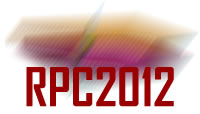Dr
Carlos Paradela Dobarro
(Universidad de Santiago de Compostela)
Since RPCs were proposed to build a time-of-flight wall for relativistic ions in the framework of the R3B experiment at FAIR-GSI [1], we have carried out an extensive programme to study the timing RPC performances under heavy ion irradiation [2, 3]. In the last two years, several detector tests at the heavy ion GSI facility (Darmstadt, Germany) and the electron beam ELSA facility at CEA/DAM (Bruyeres-le-Chatel, France) have allowed us to characterize the efficiency and the time resolution of our prototypes under different experimental conditions. Different RPC concepts (double gap, single gap) and sizes have been tested using own-developed front-end electronics together with GSI TacQuila acquisition cards.
The most promising results with heavy ions have been obtained at low-rate irradiations (several Hz/cm2) , with full efficiency for a broad voltage plateau and time resolutions below 70 ps (sigma), reaching 40 ps for electron beams with a repetition rate of 1 Hz.
[1] H. Alvarez-Pol et al. Nucl. Phys. B Proc. Supp. 158 (2006) 186-189
[2] Y. Ayyad et al. Nucl. Instrum. Meth. A (doi:10.1016/j.nima.2010.08.079)
[3] E. Casarejos et al. Nucl. Instrum. Meth. A, submitted.
Summary
In this work we will present the results obtained in beam tests performed with different glass-made RPC prototypes built at the Santiago de Compostela University using an acquisition system based in GSI TacQuila cards, which can be extended to a high number of channels.
Time resolution of a detection system based on two small size (10 cm2) RPCs, 300 um double-gap, has been measured at both the electron facility ELSA at Bruyeres-le-Chatel and the FRS and Cave C facilities at GSI. Values below 50 ps were reached for 10 MeV electron beams with different intensities and 70 ps with a low-intensity 1 GeV/nucleon Uranium beam at GSI.
More recently a larger size 300 um single-gap prototype has been measured with relativistic fission fragments as well as with a 500 MeV/nucleon Xenon beam at different beam conditions. Preliminary analysis shows that efficiencies close to 100 % have been achieved for polarisation voltages above 2700 V. For that measured values, streamer formation has not been an issue and time resolutions below 80 ps are foreseen (to be confirmed in a further analysis).
Dr
Carlos Paradela Dobarro
(Universidad de Santiago de Compostela)
Dr
Enrique Casarejos
(Universidad de Vigo)
Dr
Ignacio Durán
(Universidad de Santiago de Compostela)
Dr
Jose Benlliure
(Universidad de Santiago de Compostela)
Mr
Juan Ramón Pereira
(Universidad de Santiago de Compostela)
Ms
Noelia Montes
(Universidad de Santiago de Compostela)
Mr
Yassid Ayyad
(Universidad de Santiago de Compostela)

